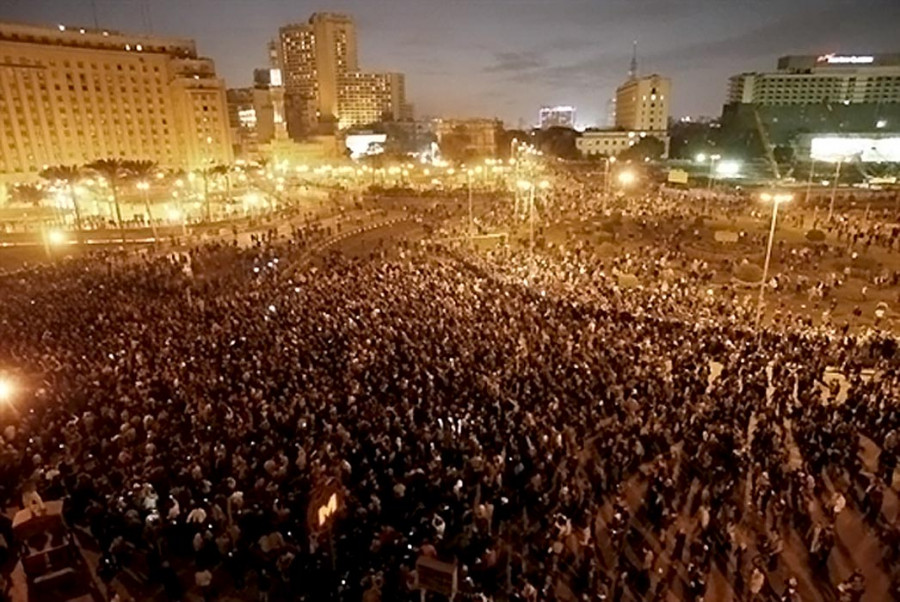Government Pulls Plug on Egypt
The Internet May Have Stopped, But It Didn’t Stop the Movement
A group of young men run along the smoke-filled streets of Cairo as the sound of choppers echo above.
A group of young men run along the smoke-filled streets of Cairo as the sound of choppers echo above.
Weaving in and out of the film’s grainy footage, they intermittently throw rocks at the advancing line of police, yelling behind their backs. In an instant a gunshot cracks out and one of them is struck, folding backwards onto the street. His friends run to him, towards the line of firing brass, screaming as they gather his lifeless body from the street.
Later that day, after millions worldwide have streamed, seen, and Tweeted clips and similar raw footage of the Middle Eastern uprising as it unfolded in realtime, the government pulled the plug and the ‘net shut down.
But instead of bringing the Egyptian resolve with it, the pressure intensifies and the images keep coming.
In one week, political uprising has occurred both on the streets of the Middle East as well as on browsers, servers and web pages around the world—breaking through attempts at censorship. Though substantial efforts were made to keep this story of civil unrest contained, with networks “falling off” the Internet, media headquarters forcibly closed or controlled and SMS/phone connections cut, the online community, active in solid international and citizen reportage, continued to keep the world updated by the hour.
Living in a world where there are just as many protestors wielding smartphones as there are with rocks, the voices of dissent have never been louder, faster and more accessible. Is censorship, with its basic attempt to disconnect, even possible today? Has Internet access become fundamental to democratic rights and freedom of expression?
Though President Hosni Mubarak’s regime shocked even the savviest of hackers by successfully pulling the kill switch on a reported 88 per cent of the Egyptian Internet last weekend, it has proven impossible to keep information restricted.
With democratic expression a central tenant in the fight today, the Mubarak regime’s systematic effort to control communication is indicative of the technological hierarchy in our media world—a world where press and broadcast stations are targeted only after the Internet goes out, where Tweets are being broadcast live and where citizens are learning to harness the power of cyber/social activism.
Since the uprising broke out Jan. 25, news sources around the world and web have also reported that other countries, specifically China, are blocking the search of “Egypt” and “Tunisia,” largely seen as a stalling tactic to suppress similar cyber movements in their own countries.
And despite a network loss for hundreds of thousands in the days of the Egyptian Internet blackout, the tech-savvy continue to circumvent the systems, sending the world this story. Though the communication services in Cairo are expected to be interrupted for yet another week, there is a growing wave of optimism that, when the Internet is eventually reinstated to all, there is no way Egyptians will go back into their homes.
A concerted push for information and resistance to censorship has also strengthened within the traditional press, as seen in backlash and international condemnation following the withdrawal of Al Jazeera’s license to broadcast in the region.
In an unprecedented move on Jan. 27, the network beckoned the public to share, link and reproduce footage and video from the uprising. All they asked for was proper citation, making all of their content in the public domain.
Though the Mubarak agenda has made every attempt to interfere with the images and information from demonstrations by journalists and citizens, the crisis remains public and on an international platform, as Egyptians continue to organize and revolt.
Ironically, perhaps it was censorship that made this footage more valuable and, at this point, we can only speculate what impact this international scrutiny will have as the story—and its geopolitical implications—continue to unfold, live before our eyes, on our screens.
Throughout the chaos, threats of oppression and shaky Internet connection, The Guardian reported Egypt currently hosts an estimated 160,000+ bloggers writing daily in Arabic, according to leaked US embassy cables. In a place where two thirds of the population is under 30 years old, they have become the voices and instigators of profound change. One of them, 24-year-old Gigi Ibrahim, spoke with The New York Times on Jan. 27 about her use of social media in both journalistic and revolutionary practices.
“Like many Egyptians here, my role is to be part of this wave of change,” she said via Skype. “[Social media is] definitely a great tool, but it’s only a tool. At the end of the day, if the people don’t decide to go down into the streets to promote change, or aren’t willing to take the risks on the streets—facing police and possible arrests—nothing can happen.
“Yes, they’re useful tools and have helped a lot in communication between the people—and communication is key here—but these social networks are used by average citizens, by political groups, activists, journalists, as an open forum for everybody to have a voice.”
As Alexandria prepares for the March of a Million today, using the web to orchestrate the protest, the rhetoric celebrating social media in this particular case is just as widespread. Certainly it is a key component in this Middle Eastern struggle, but what is truly more powerful: the tools used to organize the expressed desire for democracy, or the active follow-through?
The impetus of people to stand up against injustice, censorship and oppression extends far beyond Twitter or the Internet, and requires the masses to come out from behind their screens and onto the streets—no matter where they live.
This article originally appeared in Volume 31, Issue 21, published February 1, 2011.


